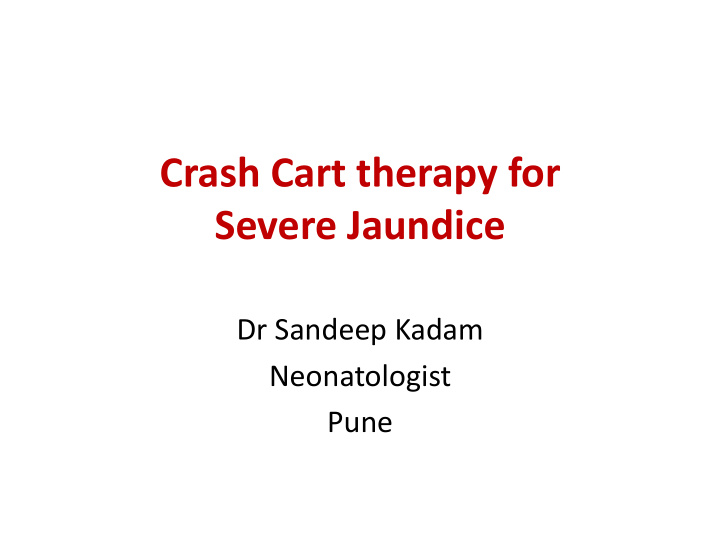



Crash Cart therapy for Severe Jaundice Dr Sandeep Kadam Neonatologist Pune
Objectives • Assessment & stabilization • Role of Investigations • Management principles
Steps for a crash-cart approach • Assess Risk • Laboratory Tests (Do not wait for labs) • Immediate Interventions • Definitive Therapy
Assessment of Severity • ? Visual assessment • Age of Onset (hrs) • Clinical signs of encephalopathy • Assess for Risk factors Transcutaneous Bilirubin and Serum Bilirubin
Visual Assessment • Skin pigmentation • Plethora • Decreased ambient light • Prior exposure to Phototherapy S. Bilirubin- Must!!
Risk Factors for severe Jaundice • Jaundice in first 24 hours • Rh/ ABO • Pre-Discharge TSB in high risk zone • Cephalhematoma/Bruising • Weightloss • Late Preterm • Previous baby with Hyperbilirubinemia
Can we Predict severe Jaundice? • Hour-specific Bilirubin values • Presence/Absence of Risk-factors
How to identify?
Risk Factors for BIND • Gestation And birth weight • Hemolysis and G6PD • Asphyxia • Sepsis • Metabolic Acidosis • Temperature Instability • Albumin <3g/dl
Clinical Signs of BIND • Mental Status • Muscle Tone • Cry
Condition 1 point 2 points 3 points Mental Sleepy, Lethargy, irritability, very poor feeding Semicoma, seizures, Status poor apnea feeding Muscle Slight Moderate hyper- or hypotonia Severe hyper- or Tone decrease depending on arousal state, mild hypotonia, arching, posturing, bicycling opisthotonus, fever Cry High- Shrill and frequent or too infrequent Inconsolable or only pitched with stimulation Total score: 1-3 Stage IA: minimal signs of encephalopathy points 4-6 Stage IB: progressive, but reversible with treatment points 7-9 Stage II: advanced, largely irreversible, but severity decreased points with treatment
Crash Cart Approach • Thermal stability • Intravenous fluids if dehydrated • Cross match and Organize for blood • Intensive Phototherapy • Repeat TSB within 4 hours • If TSB still >ET threshold Immediate ET
Crash Cart Approach • Severe Jaundice with neurological Injury: Exchange Transfusion • Severe Jaundice without encephalopathy: Interventions to reduce Bilirubin
Clinical Assessment • Head to toe physical • Weight deficit • Assess hydration and feeding adequacy • Signs of Bilirubin encephalopathy
Emergency Laboratory Tests • Serum Bilirubin levels • DCT, Retic count • Haemogram and PBS • Mother and Babies blood group • G6-PD • S. Albumin, electrolytes
Bilirubin reducing measures • Intravenous Fluids • Intensive Phototherapy • Exchange Transfusion
Phototherapy • How to give Effective Phototherapy? • What to monitor? • When to Stop Phototherapy?
Starting PT • AAP nomograms • Weight and gestation • Age of life in hours • Risk factors for BIND
AAP Nomogram for PT
Effective Phototherapy • Intensity of light • Spectrum of Light (460 to 490 nm) • Surface area of Exposure • Baby Characteristics – Hydration, Feeding, Temperature
LED Phototherapy
Distance of the light source • Irradiance is maximized of PT is close to the infant as possible • As close to the baby as possible without overheating
Reflecting lights • Aluminum foil or white cloth placed on either side of the infant to reflect light will increase irradiance Hansen et al; Semin Perinatol. 2011;35(3):171-4 Djokomuljanto S; Arch Dis Child 91:F439-F442, 2006
Care during PT • Repeat TSB after 2-4 hours of initiation of PT • Continue feeding/ Tube feeds • Ensure Hydration • Continuous and uninterrupted PT
Monitoring and Stopping PT • When baby is under PT : Monitor with TSB • Frequency of monitoring : Level of bilirubin • Stop PT – If level of bilirubin is 1 to 2 mg/dl below threshold • Monitor for rebound 12 to 24 hours later
Exchange Transfusion • TSB levels (AAP Nomogram) • Intensive PT fails to produce a significant TSB reduction i.e. > 0.5 mg/dL per hour or > 2 mg/dL drop in 4 hours
Exchange Transfusion • Rh Negative – Hydrops – Cord Bilirubin >5mg/dl – Rate of Rise >1mg/dl/hour • AAP Nomogram for >=35 weeks of gestation – >Threshold for 6 hours after starting PT – Bilirubin Encephalopathy – If Bilirubin/Albumin Ratio >0.7 in term infants
AAP Nomogram For ET >=35 weeks
Procedure of Exchange • Double Volume • Push and Pull Technique • As early as possible • Ensure stability
Blood for ET • Depends on mothers blood group – If Mother is O, Donor blood be O group – If mother is Negative, Donor blood be Negative – Other cases Baby's blood group Mother Baby Donor group O +ve A – ve O -ve B – ve A +ve A – ve AB – ve B + ve B -ve NJ - 32 Teaching Aids: NNF
Parenteral fluids • Dehydration • Weight loss > 10 % • S. Sodium > 150 • Poor oral intake • Monitor electrolytes
Pharmacologic Options • Limited role
Albumin Infusion • Albumin infusion (1 g/kg) was considered before ET • TSB doesn’t correlate with total body Bilirubin hence clinical role not justified Ahlfors CE: Indian Pediatr 47:231-232, 2010
IVIG • Severe Hyperbilirubinemia due to blood group incompatibilities • IVIG (0.5-1 g/kg over 2 hours) is helpful if the TSB is rising despite intensive phototherapy or if the TSB is within 2 to 3 mg/dL of the exchange level Alcock GS et al: Cochrane Database Syst Rev 3:CD003313, 2002
Phenobarbitone • It accelerates Bilirubin excretion by increasing hepatic clearance • No longer recommended • Sedation, slow onset of action
Tin Mesoporphyrin • Heme oxygenase inhibitor • Not approved for use
Carry Home Messages • Severe Jaundice- medical emergency • Start Intensive PT immediately • Assess and send lab • Neurological involvement: ET • Hydration • Preparation for ET • Aggressive Supportive care
Thank you
Recommend
More recommend